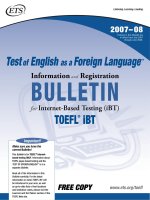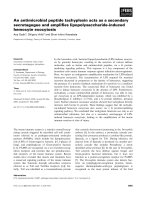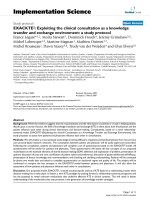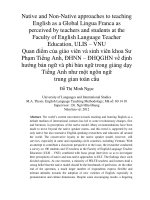ENGLISH AS A LINGUA FRANCA AND APPLIED LINGUISTICS
Bạn đang xem bản rút gọn của tài liệu. Xem và tải ngay bản đầy đủ của tài liệu tại đây (564.11 KB, 15 trang )
THAI NGUYEN UNIVERSITY
SCHOOL OF FOREIGN LANGUAGES
FINAL ASSIGNMENT
APPLIED LINGUISTICS
FIVE ARTICLES OF ENGLISH AS A LINGUA FRANCA AND APPLIED LINGUISTICS
Supervisor:
Duong Duc Minh Ph.D
Student:
Dang Thi Hien
Date of birth:
04-08-1993
Course:
5B (2020 -2022)
Class:
MA Class - K5B
Thai Nguyen – 4/2021
1
Comments
……………………………………………………………………………………….
……………………………………………………………………………………….
……………………………………………………………………………………….
……………………………………………………………………………………….
……………………………………………………………………………………….
……………………………………………………………………………………….
……………………………………………………………………………………….
……………………………………………………………………………………….
……………………………………………………………………………………….
……………………………………………………………………………………….
……………………………………………………………………………………….
……………………………………………………………………………………….
Mark………………………………………………………………………………..
Marker 1
……………………………
Marker 2
………………………………
2
Table of content
I.
II.
III.
IV.
V.
Introduction of Applied Linguistics and its scope.
Definitions of English as a Lingua Franca
Brief five articles contents
Analyze critical of Applied Linguistics with the five articles
Conclusion
References
Introduction
3
What is Applied Linguistics? and its scope?
Applied Linguistics is set out to investigate and understand the facts of language use, to help to
organize and formalize what we know, and to subject our knowledge to rational consideration
and critical analysis to make a correct decision in the real world. (Cook. (2003). Applied
Linguistics. P:5).
The scope of Applied Linguistics: The areas can be identified under three follow headings:
Language and education include first-language education, additional language education,
clinical linguistics, language testing. Language, work, and law comprise workplace
communication, language planning, forensic linguistics. Language, information, and effect
include literary stylistics, critical discourse analysis (CDA), translation and interpretation,
information design, and lexicography.
What is English as a Lingua Franca?
What is a lingua franca? The term “lingua franca” refers to a language variety used between
people who speak different first languages and for none of whom it is the mother tongue
( Jenkins 2000). According to House (2003:557), it is not a restricted code, but a functional
language “serving as a contact language between persons who share neither a common native
tongue nor a common national culture, and for whom English is the chosen foreign language for
communication (Firth 1996: 240). Seidlhofer (2001) described a lingua franca- in the strict
scene of the world as “An additional acquired language system that serves as a means of
communication between speakers of different first languages, or a language by means of which
the members of different speech communities can communicate with each other but which is not
the native language of either- a language which has no native speakers (Seidlhofer 2001: 146).
English as a Lingua Franca is used for clarity and comprehensibility rather than conformity to
one of the existing standards. ELF’s purpose is for international communication in which native
speakers may need to adjust their language to a new norm. (Cook (2003: P.29).
Five- article content Briefs
4
This article is the
research of English
as a Lingua Franca
in
Europe:
Challenges
Applied
by
for
Linguistics
Seidlhofer,
B.
Breiteneder, A and
Pitzl, M in Annual
Review of Applied
Linguistics
(2006),
printed in the USA
by
Cambridge
University Press. The
research
discussed
the possible intrinsic
of the learners of
ELF
in
the
way
achieve language and
English
in
communicative
purposes and gave
some
future
directions for linguistic
research and demonstrate the challenges that ELF can pose in a variety of areas of Applied
Linguistics. The article analyzed the functional profile of English in Europe and gave the original
way how English become lingua France across Europe in which multilinguistic cultures
developed. English impinges on each country in Europe's people's life from news like CNN,
MTV to slogans in commercial adverts, to education, scientific research, and religious activities.
Before and after World War II, English gained importance in Ẻuope ( Hofmann, 2000: Truchot,
2002) and gradually become the dominant language between countries in Europe even here is the
5
place of multilanguage. Because of the internationalization of the economies in Europe, English
forms an integral part of professional life among nations, companies. At present, English has
become a lingua franca, a language of wide communications by two directions: top-down in the
various professional domain and bottom-up in daily encounters of all levels in society. ELF
supports people to connect in common interests and concerns in multicultural communities in
Europe. The article showed the ways in which English is being used with two forces: one for
conversations and the other for innovation. Overview of current empirical work of English in
Europe, ELF contributions in a variety of corners of lives deeply in casual conversation and in
discussions at international conferences, business meetings. Here, the research referred to the
role of ELF in norms in which language and culture, and social etiquette posed. There are two
studied cases given, one based on working group discussion concerned with European higher
education and the other one draw on an ELF interaction in businesses context to conclude that
ELF speakers cannot be labeled language learners but they are acknowledged as independent
language users for their specific communicative targets. The last one, the article discussed the
future directions and challenges. One conception that the English learners target not only on
understanding the British culture, it also can be a way of accessing to any cultures, particularly
with the Russia in which ELF plays an important role to change the shape of mind of the English
learners coming from multilingual zones. Another challenge is that ELF needs to be changed
and up to date frequently alongside culture development and language teaching and learning.
Growing the awareness of the emergency and significance of ELF will bring about a change in
the actual practice of English teaching. The second challenge that ELF needs to care about is the
objective to foster an understanding learning of how language, in general, operates in similar or
different ways across communities with different languages. Besides ELF, Applied Linguistics
need to develop alongside to support language teaching in multilingual zones here. The
development of language awareness is directly related to the central question of European
language policies, should or should not relate to all the other several languages of Europe at the
individual as well as at the social level (Gupta, 2001; Lever, 2003). There is a big question for
not Europe only, but EU in particular, how to deal with its complex linguacultural situations in
small groups, small countries, ethnic groups, and languages. It has remained a big barry beyond
the boundaries of nations and individual languages.
6
This article is published
in English Today 94,
Vol
24,
No.2
(June
2008), printed in the
United
Kingdom
Cambridge
Press,
by
University
was shown by
Mario Saraceni used as
a
recount
of
pre-
publication stages of the
volume English in the
world: Global Rules,
Global Roles by Rani
Rubdy
(2006),
to
highlight some aspects
of the current debates
about the English as a
lingua franca: between
form and function in the
development
international
as
an
language
and debated about the
questions of Which English should we use? What is English? In the article, Pre-history of
English before became a lingua franca, there are two terms as two courses of teaching English:
English as a World Language and World Englishes. One focuses on pedagogy and the other
literary one, but they are apparent that the idea of singular English used around the world or that
that of a plurality of Englishes used in different parts of the world both important. However, ELF
appears new, exciting, and empirical researches. This article debations of ELF are given, some
convinced, some still not. World English (WE) model has displayed some limitations in the
Outer-circle setting where English is used intra-nationally and in Expanding-circle where English
is used mainly as an international language. When some scholars developed a new modal to
7
analyze English in the world: English as a Lingua Franca (e.g. Jenkins, 2000) for international
communication rather than the peculiarities of variety of English used intra-nationally. For most
users of English around the world, English is a convenient and practical tool for international
communication, it is very different use from English as a Native Language (ENL), which has a
function of a national language, so a new model needed to alternate ENL and closer to needs of
international users of English, that is ELF. It is a big challenge for ELF to develop as an
international foreign language because ENL still has been seen as the best model of English in
the world in teaching and practicing in education, communications. ELF project was based on
the assumption that the ELF speakers were not primarily concerned with emulating ways that the
native speakers use their mother tongue within their communities, ELF only focused on
efficiency relevance, and economy in language learning and language use (Seildhofer,
2004:141). The epistemology of English as a Lingua Franca shows all the authors discussed WE
and ELF not as antagonistic but as aspects of the same phenomenon and existed varieties and
uses of English outside and beyond ENL that need to be granted full recognition.
8
This article was
published
in
Intercultural
Communications
Studies, XVII:4
2008, By Zoya
Proshima,
Far
Eastern National
University,
which mentioned
the attitude and
conception
changes
of
Russian toward
English
in
English
as
a
Lingua
Franca
and
a
big
revolutionization
in both Russia
linguistics
and
pedagogy.
The
article discussed
how
English
turned English as
a Lingua Franca
in Russia. The
author
argued
ELF ideas are to
find ways to the
minds of Russian
linguists
and
educators. There is a
practical need for communicating with non-native speakers through English, which raises
questions of the so called intermediary translations that accepted Russian English identity
required for spreading information about Russian culture in the world. Scholarly works are rarely
published in English since the requirements for dissertations and numbers of Russian grantedsupported projects are that the results of researches be published in Russian. However, English is
indispensable for the purposes of intercultural communications where English dominates over
the other languages, even native languages of communications. This situation necessitated
Russian scholars embarking on the intensve study of World English and intercultural
communication. English become Lingua Franc in Russia and mainly affected English and Russia
9
interaction, resulted in the nativization of English in Russia and Englishzation of Russian.
English
This
Article
chapter
is
18
in
in
Exploring
the
Dynamics
of
Multilingualism
(2013), published by
John
Benjamins
Publishing Company,
wrote by Hulmbauer,
C & Seidlhefer, B. In
this
chapter,
authors
the
investigated
the use of English as a
Lingua
Franca
interaction with other
languages
in
linguistically
diversified
settings
and examine the ways
in
which
employed
ELF
is
by
plurilingual European
speakers. On the one
hand, this concerns the speakers’ strategic adaptation of linguistic elements according to their
specific communicative purposes. In this chapter, the authors have identified patterns of
accommodation techniques and joint negotiations of meaning among ELF users. On the other
hand, these processes have themselves proven to be interwoven with the speaker’s overall
linguistic repertoires and have thus shown ELF to be a multilingual model. The analysis has shed
light on diverse manifestations of this linguistic diversity within ELF. Two majors findings have
10
emerged from the investigation of Lingua Franca communication. (1) Regardless of differences
in first languages, plurilingual speakers share plenty of skills, knowledge, and resources which
they mobilize in order to achieve their communicative goals. (2) Intercultural communicators
employing a lingua franca mode exhibit considerable flexibility and integration of linguistic
resources rather than sticking to stable, strictly demarcated codes. There is thus flexibility
beyond the fixed. We analyze ELF interactions as representative of today’s intercultural
communication practices and concluded that there is a need for reconsideration of established
categories such as stable speech communities, refined languages, and additive multilingualism.
11
This article was written
by
Clara
Pignataro,
published in TEST A
FRONTE
in
TOWARDS
A
GLOBAL
LITERATURE, No 48,
published
Milano.
in
1989,
This
article
mentioned,
interpreting
in
the
scenarios,
the use of English as a
lingua
franca
has
become a worldwide
phenomenon in many
domains:
in
inter-
linguistic/cultural
settings, from the north
African
illegal
immigrant
seeking
political asylum to the
European
Member
of
Parliament’s speech. (Kellet Bidoli 2012: 21). This poses challenges to interpreting and the
consequences of this development for interpreters have not been studied in depth (Albl-Mikasa
2002: 126). Interpreting from ELF speakers is concerned, we are assuming that there does exist
an additional processing cost as regards the linguistic and cultural transfer when having to
interpret from a non-native speaker. Some of these difficulties may arise from pronunciationrelated aspects (Jenkins 2000), from lexical or syntactical deviation from standard English,
fluency, and prosodic-related factors (Albl-Mikasa 2010). These are some of the factors that can
cause considerable stress for the interpreters with a negative impact on interpreted speech
12
quality. This is the hypothesis that we intend to test with our corpus-driven research. If it is true
that the language is not static and the creativity in language can not easily be stifled students
should be made aware of this notion in the early stages of their training. Communication in ELF
interactions is sometimes more stressful for interpreters, due to phonologic and pragmatic
features of ELF. Therefore, given the growing importance of the international spread of ELF, we
as interpreters and interpreters trainers, cannot neglect its impact on the English language itself
and on the interpreting performance quality. We should try to perceive ELF as an additional
language or a co-language, functioning not against but in conjunction with the local language,
and make our trainee interpreters aware of this notion.
Analysis
All these five articles are discussing English as a Lingua Franca, where Applied Linguistics is
applied on all corners of language applies in which the language development closely process
with the cultural relationship. With the shift of English use role in the world, conversed from as
an English as a Native Language (ENL) to the language as a Lingua Franca, Applied Linguistics
sets out to investigate appeared problems in the communication field in which related language
issues implicated to both education and society. Educationally, When English first appeared as a
Lingua Franca makes a big change in many corners of life, especially in English Language
Teaching (ELT) field in many countries in the world. At first, English was taught as a World
Language, and there is a set of rules that the learners need to follow to make English standard in
varieties fields from tests, science, commercial advertisements. English native speakers seemed
to be a mirror to reflect the learners’ ability and proficiency, but
English shifted into
international language, as a lingua franca, everything converses and changes in many multiple
cultural areas in which English now becomes dominant while still want to remain the role of
their own mother language. The prominence of ELF by its nature also poses a considerable
challenge to existing established attitudes toward the nature of English and its teaching. It is
therefore important for Applied Linguistics to address concerns by both teachers and learners to
the new ideas about ELF in practice. In another corner of education, translation is a place in
which every step decisions must be taken care to provide explanations and detailed information
for the original sources. When English became a language as a lingua franca, the theories and
practices of translation have to be changed. The degree to which translator should attempt to
render exactly what is said under their not only linguistics matters but also cultural ones. The
13
relationship between language and culture is not simple, translation can not be conducted by
linguistic level purely, it must be incorporated cultural and contextual factors in which applied
linguistics activates its aspiration. When English became the international language used in many
different cultures and society forms, it requires respect with each participant in the conversations
with their full country culture and etiquette, wherever they come from. Therefore, the study of
cross-cultural communication has often been a concern in ELF both teaching and learning in
which native speakers need to adjust themself to a new communication norm, even they get
familiar with previous standards of English as a Native Language. Applied Linguistics plays a
necessary role here to adjust the visions of both English learners and teachers to be suitable with
new norms in this new field.
Moreover, the role of English as a Lingua Franca connects closely with a variety of English used
in different fields of materials. The matter is considerably more complex when learners need to
use English outside communication concerning the difference in British and American culture.
Applied Linguistics need to clarify the cultural content of English as a lingua franca can be
customized according to learners’ need or language itself needs. “ What applied linguistics can
do is to offer informed insights so what when decisions are made, as they necessarily must be in
professional practice, both the facts and various interpretations of then are as clearly formulated
as possible. The fraught area of intercultural communication is, in the modern world, at the very
heart of applied linguistics” (Cook- Applied Linguistics. 2003.P.59)
Conclusion
To have a common sense of community, a common language is indeed needed, but the
appearance of English as a lingua franca is seen as a threat to many different cultural zones in the
world. Therefore, how can one common language for the community while supporting equal
rights for all community languages at the same time is one of the most challenging tasks for
Applied Linguistics. Applied Linguistics’ role here is to grow awareness of the emergence and
significance of ELF can bring about changes in the actual practice of English teaching and
learning in multicultural zones in which at first English seen as English as the Native Language,
but now ELF as an independent concept whose linguacultural norms are not controlled by native
speakers. We will often include speakers of different language backgrounds communicating
through English in ELF, but the main focus on both English as a native language and English as a
14
lingua franca, and the culture, the primary purpose of the language is to communicate, or even
commune, with its native speakers.
References:
Cook, G. (2003). Applied Linguistics. Oxford University Press. Hong Kong.
Hulmbauer, C & Seidlhefer, B. “English as a lingua franca in European multilingualism”:
Exploring the Dynamics of Multilingualism (2013). John Benjamins Publishing Company
/>
Pignataro, C. (1989). “English as a Lingua Franca (ELF) and Interpreting” (No 48): TEST A
FRONTE in TOWARDS A GLOBAL LITERATURE, Milano.
/>
Proshima, Z. (2008). “English as a Lingua Franca in Russia” (XVII:4): Intercultural
Communications Studies. Eastern National University.
/>
Saraceni, S, (June 2008). “English as a lingua franca: between form and function”: English
Today ( 94, Vol 24, No.2). Cambridge University Press, The United Kingdom.
/>
Seidlhofer, B. Breiteneder, A and Pitzl, M (2006). “English as a Lingua Franca in Europe:
Challenges for Applied Linguistics”. Annual Review of Applied Linguistics. Cambridge
University Press, The USA.
/>ALLENGES_FOR_APPLIED_LINGUISTICS
15









